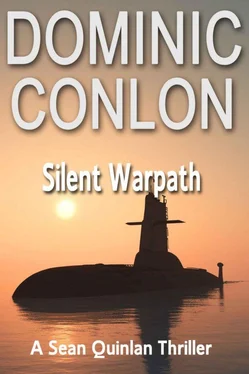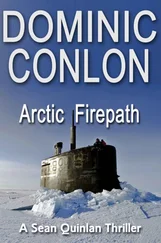‘Engineering parties to the breach.’ he ordered.
At that second, the sound and vibration from the hull lessened quickly and then stopped altogether. As the engineering parties began to report the status of the hull, the Captain’s thoughts switched from the earlier threat to the more immediate one — with the hull breech, how was he going to save his boat from sinking?
* * *
‘Con, sonar. I have a report. Sounds like a Russian Typhoon class submarine, bearing 275 degrees, range approximately 12 kilos.’
‘OK sonar. Warfare, assign more choppers to target.’
The Warfare operator turned to a separate mike and thumbed the switch.
‘Dispatch, I have orders from the con to reassign northern most helis in the box to the area of SY-PB15. Russian sub has been detected and we need all available resources on the target. Acknowledge please.’
McIver was listening to the radio chatter over the loudspeaker in his quarters. Quietly he was pleased with the performance of the sonar detection ring provided by the helicopters. Picking up any sub through the normal noises made by the bumping and grinding of the pack ice made it difficult, especially when trying to identify one of the quietest subs in the Russian navy. The speaker blipped again with static.
‘Flight, con. Two helis reassigned, but experiencing difficulties.’
DD’s idea of stringing together sonobuoys crammed full of Wi-Fi gear was a good one, reflected McIver. But they hadn’t thought about the practical issues. The number of sonobuoys each helicopter had to pull through the water caused so much drag on the booms that they had to slow their forward speed to prevent the boom from breaking off.
This meant they were unable to cover the area as fast as they would like, so the whole process slowed to a crawl. Nevertheless the aircrew persevered — though none had so far found any trace of Cetus.
McIver’s phone buzzed.
‘Jock — I’ve briefed the President, but the Russians are still not playing ball.’ The Admiral’s exasperated voice crackled out of the speaker. ‘The bastards just don’t believe us and they won’t tell us the Kougar’s position. The best we can do is to get them to warn the Kougar’s captain about a potential attack, but they’re not taking it very seriously. I just hope they’ll send the message in time.’
‘OK Admiral, you…’. The rest of the message was drowned by a loud klaxon. An anxious officer appeared.
‘What’s happening?’ queried McIver.
‘We’ve just started to pick up really high amplitudes about 10 km away, so it could be Cetus.’
A stir of excitement worked its way quickly through McIver’s bloodstream.
‘You’re dammed right! Task all our helis to find the source’ he barked. The officer waited for any further instructions.
‘Immediately!’ McIver roared.
* * *
‘Engineering parties report!’
The one thing which kept hope alive for Captain Vasily Toporov was the build of the Kougar . In terms of its construction it was a magnificent piece of Russian over-engineering. Its multi-hulled design afforded five inner hulls inside a superstructure of two parallel main hulls. It would take more than a breach of the outer hull to sink the boat.
‘Breach now under control, captain!’
‘Very well. Bring us to an even keel and take us up to 100 metres.’ He paused. ‘Sonar, do you still have a firing solution?’
‘Yes Captain!’ Polichev replied smartly.
‘Fire tubes two and three!’
‘Firing tubes two and three’ echoed Polichev. Seconds later, ‘Torpedoes have cleared tubes, running straight!’
* * *
‘We’ve got an acknowledgement from Cetus!’ the Executive Officer said. He saw the Admiral look puzzled. ‘Cetus has acknowledged our signal to cease its attack and surface’ he explained.
‘Good’ said McIver, ‘but don’t forget we have a Russian sub about, with a captain like a bear with a sore head. Be ready for evasive action.’
It was a minute before anyone realised just how much foresight the Admiral had.
‘Torpedoes in the water!’ the loudspeakers blared.
‘Bugger’ said McIver under his breath.
Captain Armstrong turned to the C-in-C. ‘Launch counter-measures, full turn to starboard and get those helis to provide a diversion — torpedoes, depth charges, everything they’ve got.’
‘Yes Captain. Torpedoes are fifty seconds from us, coming straight and true.’
‘Fire parties, to your stations’ barked Armstrong. He raised his wrist watch to count down the seconds to impact.
A full array of military hardware now came into play. From the decks of the USS Port Royal a series of vertically launched Anti-Submarine Rockets burst from their cells. The VL-ASROCs carried Mark 54 torpedoes which could be delivered to the sea in seconds. Of the three marine patrol aircraft from the carrier Carl Vincent providing 24-hour cover, the one closest to the torpedo track launched its anti-submarine Compact Rapid Attack Weapon. Basically an air-dropped lightweight torpedo, it struck the sea at the same time as the ASROCs, right in the path of the first torpedo from the Kougar . Programmed to explode on proximity, it detonated and triggered the Kougar’s torpedo warhead.
The lookout on the bridge relayed the information first. ‘Explosion off our bow, one kilometre.’
This time they were all facing forward. Through the bridge windows a plume of water hung in the air.
‘Sonar, con. Anything else in the water?’
‘Second torpedo, homing in’ came an excited reply.
The ship juddered and the sound of a massive explosion could be heard.
‘Fire parties report!’ commanded a grim looking Captain Armstrong. He stopped and grabbed a mike. ‘Weapons control, provide a firing solution.’ He looked across at McIver, only to see him shake his head.
‘No Jim. Not today.’ McIver inclined his head, inviting the Captain to a quiet corner of the bridge.
‘I know how you feel. God knows, I feel angry too. But we’re not going to get involved. Get in touch with the Russian. Tell him we are not — and repeat not — engaging with him. Tell him we are on a peaceful mission to retrieve a lost sub.’
Captain Armstrong walked away, too angry to reply.
‘Sir’ shouted a sonar operator. ‘We’ve just lost contact with Cetus. The friggin’ sub has dropped out of sight!’
The seaman presented the message slip to Captain Armstrong. He read it quickly and turned to everyone around the table.
‘It’s a signal from the Captain of the Kougar. They’ve acknowledged our message and are standing down.’
Natasha and everyone else around the table breathed a sigh of relief.
‘Thanks to Louis we were able to secure Cetus.’ Captain Armstrong raised his glass and everyone round the table followed suit.
When the Cetus was reported missing after the torpedo explosions, she really thought that it had gone. She felt so bad she could taste bile in her mouth. But Louis didn’t appear at all concerned. He tapped out a code onto his laptop and five minutes later Cetus emerged on the surface. When he saw the puzzled looks from everyone around the table, Louis explained that one of the low-level programs on the sub made it dive whenever any potentially threatening situation occurred.
The Kougar’s torpedoes had initiated the automatic protection circuit in Cetus, forcing it to dive to a depth of 20 metres. When Louis typed in the counter-code, Cetus slowly reappeared.
While the ship was being repaired, Natasha and Louis made their way to the now stationary Cetus. Natasha’s long hair streamed out from behind her in the wind. She felt some spray on her face as the motor launch ploughed through the choppy seas towards the small dot on the horizon ahead. She had rarely felt such a mix of emotions before — a sense of relief that the sub had been found, a sense of sadness of the lives that had been lost because of it, a sense of despair that the project might be closed down forever. But most of all she harboured a sense of hope for herself and Sean.
Читать дальше




![Джеймс Купер - Зверобой, или Первая тропа войны [The Deerslayer, or The First Warpath]](/books/398571/dzhejms-kuper-zveroboj-ili-pervaya-tropa-vojny-the-thumb.webp)







